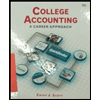
a.
A bank reconciliation statement is prepared to project the causes of the difference between the bank account balance as per the bank statement and the bank balance as per the accounting records. There can be multiple reasons why these two balances may appear to be different. Some of the examples may be that checks issued but not cleared by the bank, checks received from the customer deposited into the bank but not reflected in the statement, check from a customer returned due to insufficiency of funds, direct debit due to bank charges, etc.
The ending balance as per the bank statement and the accounting records should be the starting point and all the necessary adjustments are to be made to or from both of these balances to arrive at a common balance called Adjusted Balance. While arriving at the uniform adjusted balance proves the accuracy of the bank reconciliation statement.
Requirement 1
To prepare:
The bank reconciliation statement of the Branch Company as of July 31st.
b.
The month-end journal entries are required to be passed for only those entries affecting the accounting balance for adjusting the book balance to the reconciled balance. These entries will alter the cash balance and bring it up to the adjusted or reconciled balance.
Requirement 2
To prepare:
The journal entries as of July 31st register the reasons for differences between the balance as per the statement and as per the books.
Want to see the full answer?
Check out a sample textbook solution
Chapter 6 Solutions
FINAN+MAN ACCT (LL)W/ACCESS+PROCTORIO
- You made a sale for $175,000. The customer paid in cash. Your gross margin is 48%. What is your cost of goods sold?arrow_forwardSuppose the nation of Bittle produces only two goods, teapots and surfboards. If Bittle produces teapots, it can make 40 per day. If Bittle produces only surfboards, it can make 70 per day. What is the opportunity cost of one teapot in Bittle?arrow_forwardsubject: general accountingarrow_forward
- Answer me this accounting reasoning Questionarrow_forwardYuva Co. uses the percentage-of-receivables basis to record bad debt expense and concludes that 3% of accounts receivable will become uncollectible. Accounts receivable are $401,100 at the end of the year, and the allowance for doubtful accounts has a credit balance of $3,110. Prepare the adjusting journal entry to record bad debt expense for the year.arrow_forwardThe capital stock is fixed at 40 units, the price of capital is $15 per unit, and the price of labor is $80 per unit. Units of Labor Units of Output 5 10 15 20 40 100 180 220 If the firm produces 30 units of output, what is average fixed cost? {Financial Accounting}arrow_forward
 Financial AccountingAccountingISBN:9781337272124Author:Carl Warren, James M. Reeve, Jonathan DuchacPublisher:Cengage Learning
Financial AccountingAccountingISBN:9781337272124Author:Carl Warren, James M. Reeve, Jonathan DuchacPublisher:Cengage Learning Financial And Managerial AccountingAccountingISBN:9781337902663Author:WARREN, Carl S.Publisher:Cengage Learning,
Financial And Managerial AccountingAccountingISBN:9781337902663Author:WARREN, Carl S.Publisher:Cengage Learning,- Century 21 Accounting Multicolumn JournalAccountingISBN:9781337679503Author:GilbertsonPublisher:Cengage
 College Accounting (Book Only): A Career ApproachAccountingISBN:9781337280570Author:Scott, Cathy J.Publisher:South-Western College Pub
College Accounting (Book Only): A Career ApproachAccountingISBN:9781337280570Author:Scott, Cathy J.Publisher:South-Western College Pub College Accounting (Book Only): A Career ApproachAccountingISBN:9781305084087Author:Cathy J. ScottPublisher:Cengage Learning
College Accounting (Book Only): A Career ApproachAccountingISBN:9781305084087Author:Cathy J. ScottPublisher:Cengage Learning





